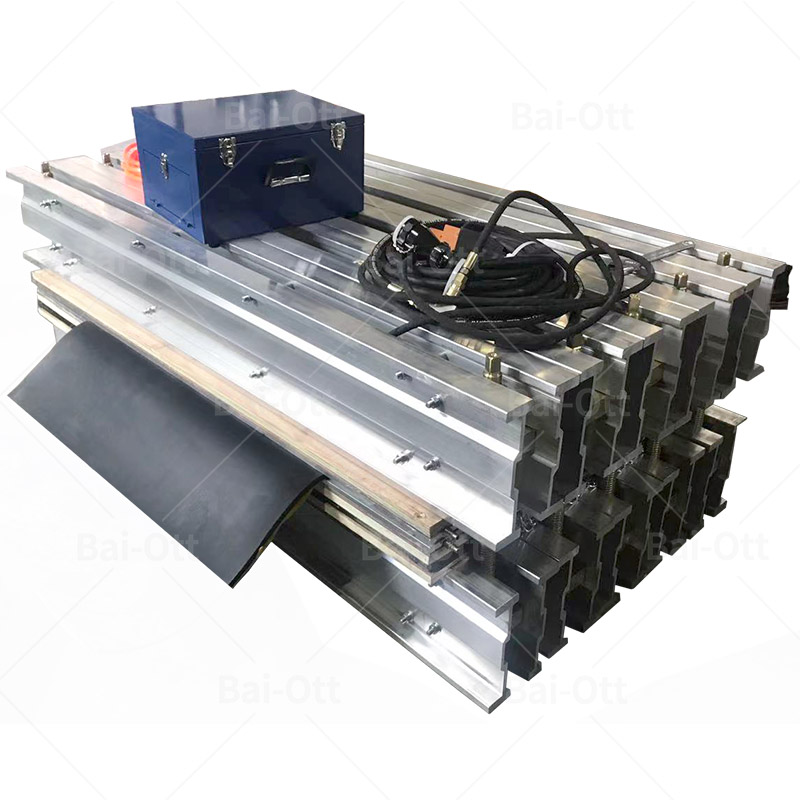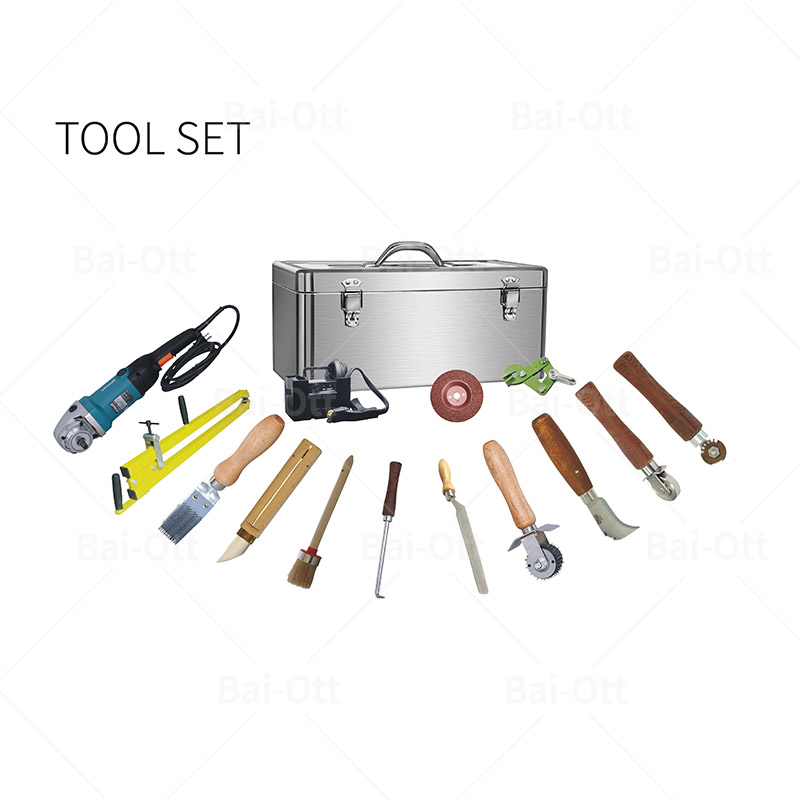Vulcanization standard of belt joint
Importance of vulcanization of belt joints
The quality of the belt conveyor joint is very important for the use of the belt. The joint is the weakest weakness of the belt and directly affects the use of the whole belt. This standard is specially formulated to ensure the vulcanization quality of the joint, standardize the vulcanization process of the conveyor belt joint of the company's belt conveyor and improve the vulcanization skill level of the belt joint.
Vulcanized joint equipment and materials
1. Two sets of water cooling electric rubber conveyor belt repair hot vulcanizer, two sets of vulcanization beds, two hydraulic presses, two thermal control boxes, one power line, two primary lines, four secondary lines, two sizing blocks, two tightening mechanisms and two large ratchet wrenches.
2. Rubber material: rubber material includes surface rubber, core rubber and mortar.
3. Tools and auxiliary materials: 8 art knives, 300 blades, 2 angle grinders, 1 terminal block, several pieces of sandpaper, 2 steel wire pliers, 2 wooden mallets, 1 2m steel ruler, 2 white pencils, a roll of thin wire, 10 nails, 8 flat paint brushes, 1 tape measure, aviation gasoline, several pieces of newspapers, 2 sets of belt clamps, 4 2T chain hoists, 4 steel wires, 4 plastic small basins, 2 buckets, 2 adjustable wrenches (10 inch / 12 inch) Open end wrench (24-27), ratchet (24-27), blower.
Preparation before joint vulcanization
1. Selection of vulcanization site
The vulcanization location shall be selected and positioned by the person in charge of the work. Generally, the place with spacious and flat, convenient transportation and close to the water source of the power box shall be selected as much as possible.
2. Fix the belt and build the workbench
After positioning, fix the belts at both ends of the joint with the belt clamp, and ensure that the belt will not slide after fixing. Loosen the tensioning device or raise the heavy hammer to ensure that the belt is loose, and enough joint space must be reserved. After the belt is relaxed, build a working platform at the vulcanization point, and lay I-shaped molten steel pressing plate and lower vulcanization plate.

Procedure and process of vulcanized joint
Joint vulcanization mainly includes the following processes: setting up platform, laying I-steel vulcanization plate, drawing line, pulling head, trimming joint, centering, cleaning steel wire, laying non working surface glue, swinging rope, laying glue, laying heating plate for fastening, heating, hydraulic pressure and disassembly after timing.
1. Determination of lap form and length of joints
For the selection of joint form and joint length, the joint form can be divided into four types, one to four levels of lapping. The factory commonly uses one level and two levels of lapping. The joint length depends on the situation, and generally defaults to one meter.
2. Mark the joint line
Draw the joint line according to the form and joint length of fluidizing plate, and draw the oblique line for the form of vulcanized plate in our factory. The slash size can be calculated with bandwidth * 1.07, and the tongue width is 50mm.
3. Remove the rubber
(1). Use the art knife to cut a V-shaped opening at the tongue position on both sides of the working face and non working face, and the depth is up to the steel wire rope.
(2). Use the art knife to make a V-shaped opening on the rubber and steel wire rope, pull out the steel wire rope, and use the art knife to remove the residual rubber on the steel wire rope.
(3). Cut off the rubber on the surface of the tongue.
4. Cut off wire rope
The factory usually adopts two-stage lapping. The steel wire ropes are 900mm respectively. Cut off the steel wire rope head with wire cutters and cut off the steel wire rope by about 20mm.
5. Burnish
Polish the glue on the surface of the steel wire rope with sandpaper, and remove the residual glue on the surface of the steel wire rope to the greatest extent without damaging the steel wire rope. The tongue is finely ground into a rough surface with an angle grinder.
6. Joint forming
(1). Draw the center line of the joint on both sides, and use the tension on both sides of the center line to find out the center of the belt. Adjust the joints on both sides to a straight line, and fix and position the two belts with iron nails.
(2). Turn the steel wire ropes on both sides and lay plastic paper on the bottom layer.
3. Clean the steel wire rope and tongue with aviation gasoline. After the gasoline volatilizes, apply 2-3 times of rubber glue evenly. The next coat of glue can only be applied after the glue is dried.
(4). Lay the non working surface rubber (stick the non vulcanized uncured tie gum and non vulcanized surface rubber together in advance), and cut the excess rubber on site according to the joint form. Wash with gasoline and glue to dry. (when laying rubber, the bottom layer of the lower heating plate shall be paved with newspaper before laying rubber, and aluminum plate shall be laid at the middle connection of the vulcanization bed.)
(5). Tighten, straighten, place and arrange the steel wire rope one by one, and keep all steel wire ropes in the same position, warped and arched.
(6). Fill the steel wire rope with long strip of core rubber (including the lap joint of both sides and middle steel wire rope)
(7). Cover the glue, use the lines drawn on both sides to make marks, cut off the excess glue, draw several lines on the glue surface with an art knife, and then smash the glue with a wooden mallet.
(8). Lay enough newspapers on the flour glue to cover it all.

7. Process requirements for vulcanization
(1). Top the sizing blocks on both sides, cover the heating plate and water pressure plate, install the I-beam, lock the nut and connect each pipeline line. When locking the large nut, lock it from the middle to both sides. When locking, it can not be in place in one step. The circular locking is gradually in place.
(2). Stop pressurizing after pressurizing to 0.8MPa with a hydraulic pump, and pressurize again to 1.2MPa after the temperature rises to 100 ℃.
(3). Vulcanization conditions
Vulcanization temperature: 145-149 ℃
Vulcanization pressure: 0.8MPa before 100 ℃, 1.2MPa after 100 ℃, vulcanization time: 30-40 minutes
(4). Dismantle the vulcanization bed
After vulcanization, it can be removed after a cooling time of 40-60 minutes (depending on the weather).
Supplementary notes
1. The vulcanization joint must use aviation gasoline, and it is strictly prohibited to use low-grade and low-quality gasoline.
2. The temperature rise during vulcanization shall be continuous, and the whole temperature rise process shall not exceed 50 minutes.
3. The gap between the two heating plates must be paved with aluminum plates, both up and down.
4. When locking the I-steel bolt, start from the middle and lock it to ensure that it is flush as far as possible.
5. During vulcanization, the pressure will continue to decrease due to the complementary concave convex of the rubber after gum softening and pressurized water seepage. Therefore, we should always pay attention to the pressure, supplement it in time when it is insufficient, and keep it at the standard value.
6. Natural cooling must be adopted in the cooling process after vulcanization. It is strictly forbidden to use the method of watering the vulcanization bed for rapid cooling.






